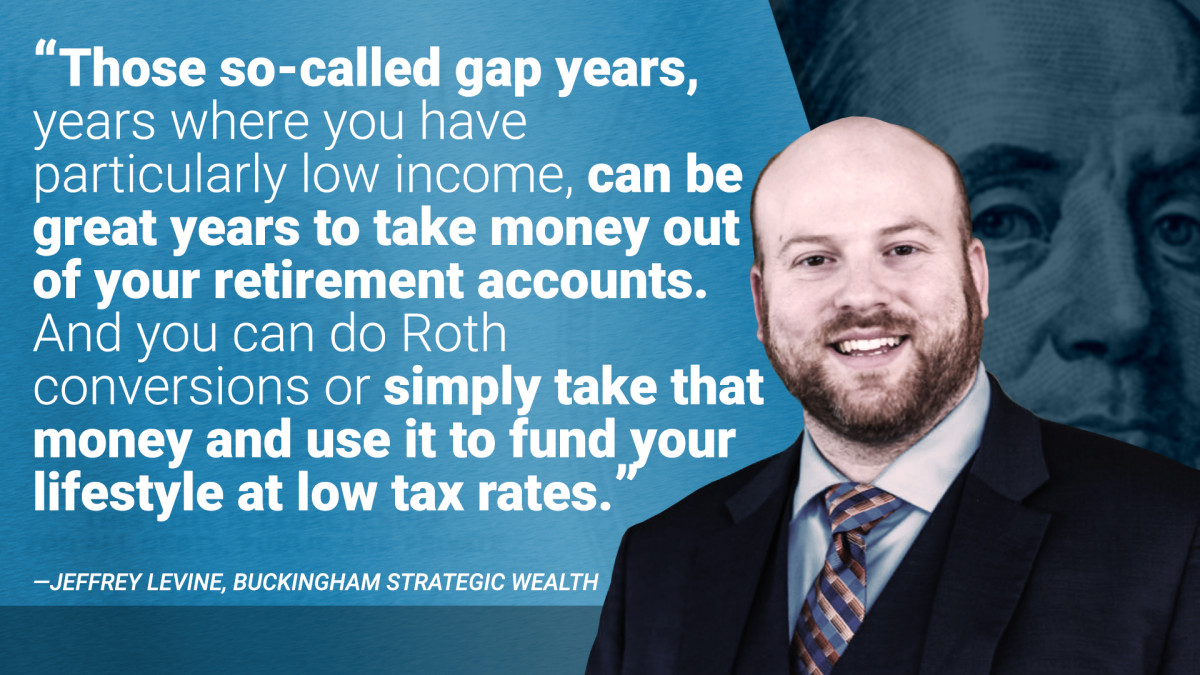Retirement Daily’s Robert Powell caught up with Jeffrey Levine, CPA and tax pro from Buckingham Strategic Wealth Partners to discuss the three ways to reduce your tax burden in retirement.
TurboTax Live experts look out for you. Expert help your way: get help as you go, or hand your taxes off. You can talk live to tax experts online for unlimited answers and advice OR, have a dedicated tax expert do your taxes for you, so you can be confident in your tax return. Enjoy up to an additional $20 off when you get started with TurboTax Live.
Recommended: TurboTax Offers 7 Tax Tips for After You Retire
3 Ways to Reduce Tax Burden in RetirementStrategically timing distributions from retirement accountsAligning deductions to maximize their valueLooking at which accounts they have and figuring out the correct order of distributions from those accountsQuotes| 3 Ways to Reduce Tax Burden in Retirement Jeffrey Levine, Chief Planning Officer, Buckingham Strategic Wealth Jeffrey Levine, Chief Planning Officer, Buckingham Strategic WealthRecommended: Can You Deduct 401K Savings From Your Taxes?
Video Transcript| Jeffrey Levine, CPA and Tax Expert, Buckingham Strategic WealthRobert Powell: What are some ways to reduce your tax burden in retirement? Well, let’s talk taxes with Jeffrey Levine from Buckingham Wealth Partners. Jeffrey, welcome.
Jeffrey Levine: Always good to be with you, Bob.
Robert Powell: So what are some ways that folks can reduce their tax burden in retirement?
Jeffrey Levine: Well, one of the first ways is by strategically timing distributions from retirement accounts. Most people know that by the time you reach 72, you generally must begin taking distributions out of your IRA, 401(k), etc.
(Note: 70 ½ if you reach 70 ½ before January 1, 2020. Secure Act recently changed the age requirement.)
Before that, though, you’re able to voluntarily take distributions, and even if you don’t need them, sometimes it can make sense. Particularly if there are years between when you retire and when you begin to take Social Security or required minimum distributions. Those so-called gap years, years where you have particularly low income, can be great years to take money out of your retirement accounts. And you can do Roth conversions or simply take that money and use it to fund your lifestyle at low tax rates. So that would be one great way.
Another great way is by aligning your deductions to maximize their value. So under today’s tax law, we have a very high standard deduction, that for married couples who are over 65 each, it’s more than $28,000 today. And because our state and local tax deductions are limited at no more than $10,000. So even if you pay $30,000 of state and local taxes between your property and income taxes, you can only take $10,000 as an itemized deduction, which makes it very hard to accumulate enough itemized deductions to be able to itemize in the first place. So one way to combat that is to bunch those deductions together. So if you give to charity, let’s say $5,000 a year, instead of doing $5,000 every year, maybe one year, you give $20,000, and the next three years you give none. That’s another critical way in which seniors can reduce their income taxes.
A third and one other important and valuable way that individuals in retirement can reduce their taxes is by looking at which accounts they have and figuring out the correct order or timing of distributions from those accounts. So, for instance, many times individuals have some money in a traditional style account like a 401(k) or a traditional IRA. They may also have some money in a Roth-style account, either a Roth IRA or a Roth 401(k), a Roth 403(b). They may also have some taxable in a joint account or an individual account or a revocable trust account in a bank or in a brokerage account. And figuring out the right order in which to tap those accounts can reduce the overall tax bill. And actually, with the same portfolio, the same investments, can extend the life of that portfolio by, in many cases, 10% or longer, which is a non-trivial amount when we’re talking about making sure you don’t run out of money before you run out of life.
Editor’s Note: The content was reviewed for tax accuracy by a TurboTax CPA expert.
Zach Faulds contributed to the writing of this article and produced the video and/or the graphics associated with it.
